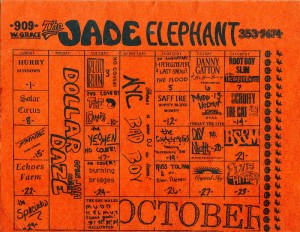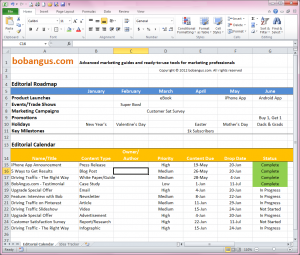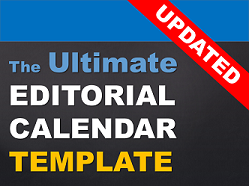Have you published a ton of content but never got much traction with your audience?
Have you logged tons of hours delivering creative but still feel rushed to meet deadlines?
Do you feel you’re firing off lots of campaigns with only small results to show for it?
Not to worry. We’ve all faced these problems.
 You need to use an editorial calendar. It’s the easiest solution to getting a grip and to start really engaging your customers and prospects.
You need to use an editorial calendar. It’s the easiest solution to getting a grip and to start really engaging your customers and prospects.
The benefits of using an editorial calendar go way beyond just organizing your messy sock drawer of blogs, social media, newsletters, email campaigns, ad campaigns and press releases. You can also achieve spectacular improvements to your subscription rates, social shares and, most importantly, sales.
You get a clearer picture of what will wow your audience while streamlining your processes for awesome production velocity.
Check out the 9 reasons why you need to use an editorial calendar to unlock the hidden potential of all your hard work:
Reasons Your Audience Will Love It
1. Be the Hot Story: Today’s hot news is always gets the best response. The good news is you already know in advance most of what’s going to be hot for your audience. The Olympics, Christmas, Black Friday, and New Year’s are all great themes to build into your content. When these big holidays or events are happening that’s what your audience is reading, consuming, clicking and buying. The good news is that you know way in advance when these big opportunities are taking place. Plan for it. And ride the wave.
 2. Report from the Scene: Similar to big events, you can stand out from the crowd by being “on the scene” for other activities or news topics that are important. Trade shows, product launches (yours or others like an Apple iPhone launch), milestones, anniversaries and big promotions. If you pay attention to what’s coming up, you can tailor you content plan to ride the extra attention these activities will attract.
2. Report from the Scene: Similar to big events, you can stand out from the crowd by being “on the scene” for other activities or news topics that are important. Trade shows, product launches (yours or others like an Apple iPhone launch), milestones, anniversaries and big promotions. If you pay attention to what’s coming up, you can tailor you content plan to ride the extra attention these activities will attract.
Not to mention, you’ll reinforce your perceived expertise and leadership with your audience.
3. Create Themes: You could use the calendar to plan weekly or monthly themes. Build a concentration of related content in different delivery formats. This builds critical mass along one major subject but allows readers to enter how and when they are most ready to engage. Once they are in, then they’ll check out your related information. You don’t take the risk of producing one campaign and missing someone for whatever reason.
4. Map Buying Stages: Another way to be successful is to funnel your audience through the buying stages – awareness, learning, comparison, purchase decision, and post-purchase. Your editorial calendar can reflect this process. You can map the types of content to the timing or triggers in a way that maximizes your conversion rates. Your prospects will happily go through the funnel with your more seamless delivery of what they need when they want it.
5. Develop Positive Habits: Planning regular daily, weekly or monthly content builds a rhythm for your audience. A regular heartbeat. What this rhythm does is it develops patterns of behavior in your audience. You generate anticipation, build expectations and create commitment. As a result, you create recurring, enthusiastic fans who will act.
 Reasons You’ll Love It
Reasons You’ll Love It
6. Increase Velocity: An editorial calendar definitely helps with you production scheduling. You see what is coming and needs working on and who will be doing it. The editorial calendar gives you oversight on everything going on. A side benefit is that your teamwork improves with all the people that help you produce and distribute your marketing campaigns. That teamwork will speed up your production cycles and lead to accomplishing more, faster.
7. Organize Creative Assets: Have you ever gotten to the end of a project only to spend 2 more days tracking down images, web URLs or reference details? You feel like you’re never done. Get that busywork (though a critically dependency) done ahead of time. I’ve added a section to my editorial calendar template that captures the list of creative assets I will need from the outset. Then I can batch the work of collecting images or finding the right video for a couple of deliverables all at once. Saves me a ton of time and I don’t miss deadlines.
8. Mind the Gap: You need the right marketing mix of content types and topics to properly deliver on complete themes or mapping campaigns to buying stages. One shot won’t do it. You can easily identify where you are light or have a complete gap by using an editorial calendar. Then you can add in what you need or repurpose existing content to quickly fill in.
9. Look Professional: Outside contributors, advertisers and partners want to do business with you. They also want to maximize their results. The best way to do that is to match their marketing to relevant campaigns or content you are producing. Magazines have always presented their editorial calendars externally to attract the best advertisers. The same can work for you. Plus, you’ll likely get the best submissions because your editorial calendar makes you look organized and professional. More so than businesses that are unorganized and will take anything they can get.
 Start Using an Editorial Calendar Now
Start Using an Editorial Calendar Now
Bottom line: An editorial calendar is the best way to plan your marketing campaigns and content strategy. You’ll be prepared to execute without rushing to meet deadlines or wasting valuable time with unorganized work. Plus, planning ahead with a calendar can take your audience engagement and results to the next level.
Get started by dowloading the editorial calendar template that I use for my launches and integrated campaigns. It is a tremendous help to me in organizing the types and timing of content that can deliver on my target results.
Plus, I can track what I need to publish, like a well-defined call to action, creative assets, source materials, and talent needs. Use this free editorial calendar template as a starting point for your marketing plan and build the best content in advance of your deadlines.
Image Credits:

[…] ?9 Reasons Why You Need to Use an Editorial Calendar […]